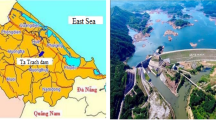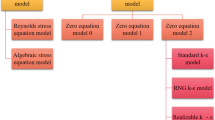Abstract
Bottom outlet tunnels are among the most important structures of dam design processes and operation which are encountered with many dangerous problems. This study investigating the flow aeration between emergency and service gates along the bottom tunnel using a large enough physical model of Karun IV Dam bottom outlet. To do so, performance of 12 alternatives was tested to select the best design. Flow characteristics of each alternative have been studied and critical design criteria in view of occurring cavitation hazard has been evaluated. Cavitation indices were calculated along the tunnel from the entrance of the intake to the outlet structure. To eliminate the probability of cavitation hazard, aerators have been designed. Results showed that cavitation hazard was not considerable along the tunnel and installation of aerators between service and emergency gates could definitely diminish the probability of cavitation. Measurements demonstrated that in 60 % opening of service gate the amount of air was maximum by value of 0.024 cm.

Similar content being viewed by others
References
Speerli, J.; Hager, W.H.: Air–water flow in bottom outlets. Can. J. Civ. Eng. 27(3), (2000)
Eddington R.B.: Investigation of supersonic phenomena in a twophase (liquid–gas) tunnel. AIAA J. 8, 65–74 (1970)
Borodina L.K.: Aeration behind low-level gates. Power Technol. Eng. 3(9): 826–834 (1969)
Peterka, A.J.: The effect of entrained air on cavitations pitting. In: Proceedings of Minnesota International Hydraulic Convention, USA (1953)
Falvey, H.T.: Cavitation in Chutes and Spillways. Eng. Monogr. USBR. 42, 29–47 (1990)
Tumbes, P.; Chanson, A.: Air Entrainment and Velocity Redistribution in a Bottom Outlet Jet Flow, IAHR Cong., Seoul, Korea (2005)
Schneider, J. et al.: The model tests of the bottom outlet of the Kárahnjúkar hydro-electric project, No. 027 (2007)
Mohaghegh P., Wu L.: Effects of hydraulic and geometric parameters on downstream cavity length of discharge tunnel service gate. J. Hydrodyn. 21(6): 774–778 (2009)
Falvay, H.: Air–water flow in hydraulic structure, US department of interior. Water and power resources service, Denver, Colorado, Engineering monograph, No. 41 (1980)
Chanson H., Brattberg T.: Experimental study of the air–water shear flow in a hydraulic jump. Int. J. Multiphase Flow 28, 583–607 (2000)
Ervin, D.A.; Falvey, H.T.: Behavior of turbulent water jets in the atmosphere and in plunge pools. Proc. Inst. Civil Engng. Part 2, 83, 295–314 (1987)
Shao, N.; Pan, J.L.: Scale effects in modeling air demand by a ramp slot. Scale Effects in Modelling Hydraulic Structures. NO. 4.7, pp. 1–5 (1984)
Smith, C.D.: Hydraulic Structures. University of Saskatchewan Printing Services (1995)
Author information
Authors and Affiliations
Corresponding author
Rights and permissions
About this article
Cite this article
Abdolahpour, M., Roshan, R. Flow Aeration after Gate in Bottom Outlet Tunnels. Arab J Sci Eng 39, 3441–3448 (2014). https://doi.org/10.1007/s13369-014-0954-5
Received:
Accepted:
Published:
Issue Date:
DOI: https://doi.org/10.1007/s13369-014-0954-5




